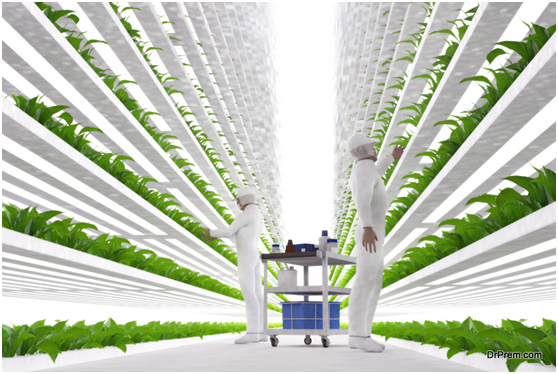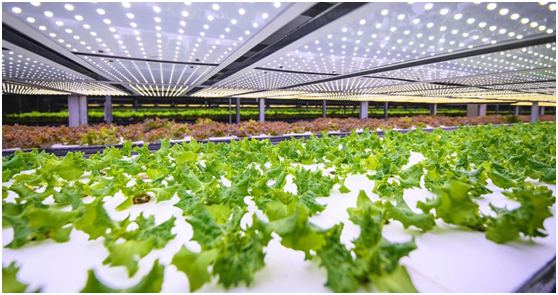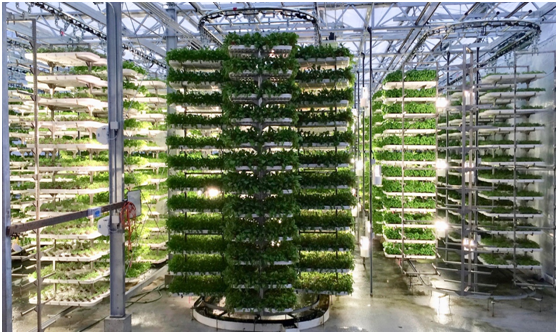
Vertical Farming
Vertical farming is an agricultural method through which crops are grown in vertically stacked layers. It is done in a controlled environment using techniques such as aquaponics, hydroponics and aeroponics, that does not make use of soil.

With a growing population and not much operational farmland to go around, vertical farming may be used to fulfill the growing food demands of the world.
Origins of Vertical Farming
The concept of vertical farming was first pioneered by Dickson Despommier in 1999. He was a professor of Public and Environmental Health at Columbia University. Challenging his students on whether food could be grown on the rooftops of New York skyscrapers, a concept was created in which a 30-story vertical farm grown by hydroponics and artificial light could feed about 50,000 people.
Although the professor’s farm was not built, the idea did take off, inspiring many later designs.
As a result, governments and developers around the world would take note of vertical farming and implement it in cities such as Abu Dhabi, New York, Los Angeles, Bangalore, Dubai, Beijing etc. Between 2014 and November 2020 about $1.8 billion were invested into startups working on creating vertical farms.
Types of Vertical Farms

The following are the known types of Vertical Farming
1. Vertical Farms in buildings
Abandoned buildings are repurposed for vertical farming, but it’s not necessary that such buildings be used often. Depending on the requirements new buildings are also used to construct vertical farms.
2. Shipping-Container Vertical Farms
Old or recycled shipping containers are equipped with LED lighting, vertically stacked farms, climate controls and monitoring sensors. Such types of farms can save space and get a higher yield in the process.
3. Underground Vertical Farms
Also known as ‘Deep Farms’, these types of vertical farms are built in underground tunnels, abandoned mine shafts or any subterranean environment. The constant temperature and humidity means that they require less energy for heating and as for water supply, the underground water source can be used. Such farms can also produce 7 to 9 times more food than a conventional farm.
Techniques of Vertical Farming
Hydroponics
Hydroponics is the method of growing plants without the involvement of soil. Here, plant roots are submerged in magnesium, nitrogen, potassium calcium etc. These solutions support roots, improving chances of higher yield and reducing dependence on water.
Studies have shown that there have been 11 times yield compared to conventional farms at a cost of 13 times less water. Thus hydroponics is the most widely used method in Vertical Farming.

Aquaponics
A slightly advanced method that Hydroponics, Aquaponics integrated production of plants with that of aquatic organisms in a closed loop system resembling nature itself.
Aeroponics
Like the name suggests, Aeroponics does not use mediums like solid or liquid, instead it uses air to grow plants. A liquid solution is used in air where the plants are located, through which the plants absorb nutrients. It is the most suited method as it requires neither water nor soil and requires no growing medium.
Advantages and Disadvantages of Vertical Farming
The following are the advantages and disadvantages of vertical farming
Advantages
1. Efficiency
Conventional farms require too much land and water, while vertical farming requires a fraction of it with more yield per acre. Another additional benefit is that vertical farming can produce crops throughout the year. Even more that one crop can be harvested at once due to their individual land and plots.
2. Weather resistant
Traditional farming is subjected to unpredictable weather patterns and natural disasters such floods, droughts, wildfires, etc. In a controlled environment of vertical farming such factors are negated and thus less susceptible to disruption in the supply chain process.
3. Environmental Conservation
Vertical farming helps in environmental conservation as deforestation that accompanies traditional farming can be negated, thus saving resources in the long run.
Producing food indoors reduces or eliminates conventional plowing, planting, and harvesting by farm machinery, protecting soil, and reducing emissions.

Disadvantages
1. Huge costs
Vertical farming is quite costly and some use urban settings where the real estate prices are high, thus, its maintenance costs are even higher as compared to traditional farming.
2. High Energy Consumption
During the growing season, the sun shines on a vertical surface at an extreme angle such that much less light is available to crops than when they are planted on flat land.
Therefore, supplemental light would be required.

Source: BYJU'S



